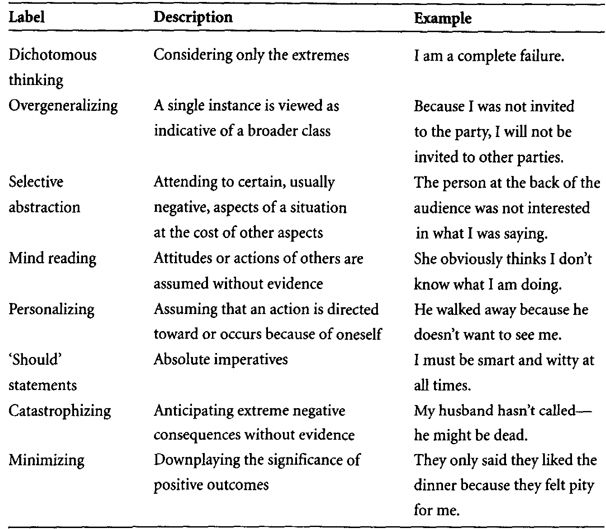
- •Isbn-10: 1-4338-0548-0
- •Introduction
- •Learning Theory: Classical Conditioning
- •Principles of Treatment
- •Role of Cognitive Variables in Classical Conditioning
- •Learning Theory: Instrumental Conditioning
- •Principles of Treatment
- •Role of Cognitive Variables in Instrumental Conditioning
- •Social Learning Theory: Self-Efficacy Theory
- •Principles of Treatment
- •Cognitive Appraisal Theory
- •Figure 3.1
- •Table 3.1 Ellis’s Irrational Beliefs
- •Table 3.2 Common Cognitive Distortions
- •Cognitive Appraisal Theory and Expectancy–Learning Theory
- •Figure 3.2
- •Principles of Treatment
- •Cognitive–Behavioral Theory
- •Minimal Therapist Contact
- •Skill- and Reinforcement-Based Strategies Self-Monitoring
- •Relaxation
- •Behavioral Rehearsal of Social Skills and Assertiveness
- •Problem-Solving Training
- •Behavioral Activation
- •Behavioral Contracting
- •Habit Reversal
- •Exposure-Based Strategies Exposure Therapy
- •Response Prevention
- •Cognitive-Based Strategies
- •Rational–Emotive Behavior Therapy
- •Cognitive Therapy
- •Self-Instruction Training
- •Indications and Contraindications for Cognitive Strategies
- •Anxiety Disorder
- •Depression
- •Alcohol Abuse
- •Bulimia Nervosa
- •Mindfulness
- •Acceptance and Commitment Therapy
- •Dialectical Behavior Therapy
- •Function Over Content
- •Incorporate advances in learning theory
Table 3.2 Common Cognitive Distortions

6. Schemas are at best an approximation of experience, in that all information processing is egocentric and therefore a biased representation of reality. What distinguishes cognition between disordered and nondisordered states is the degree to which the former is influenced by pre-potent dysfunctional schemas.
7. Schemas develop through repeated interactions between the environment and innate rudimentary schemas. That is, they develop by increasing elaboration and connections with other schemas, and those schemas that are activated more frequently become more elaborated and therefore more dominant in the overall organization of schemas. For example, the more often the schema of being unlovable is activated, the more likely the concept of being unlovable will dominate interpretations of ongoing situations. Furthermore, schema development is additionally influenced by genetic or biological propensities.
8. Schemas are organized in different levels. The most basic level is single schemas. Single schemas then cluster together to form nodes, or the cognitive representation of psychological disorders. Nodes then interconnect with other nodes as the cognitive representation of personality.
9. Schemas are characterized by different levels of threshold activation, which occurs through a match between stimulus features of the environment and relevant schemas. Schemas that are more frequently activated have lower thresholds for activation and thereby are hypervalent and more dominant. Dominant schemas become activated by a wide array of environmental stimuli and trivial matching stimuli; they are easily accessible, dominate information processing once activated, and resist deactivation.
10. Two general orientations are represented, the first aimed at the primary goals of the organism (or schemas involved in meeting the basic needs necessary for survival) and the second aimed at secondary constructive goals (or schemas to do with preservation, reproduction, dominance, and sociability). Most primal processing occurs at automatic or preconscious levels and tends to be rigid and inflexible, whereas processing at the secondary level is more conscious and controlled. In psychological disorders, the primary schemas have become more dominant and the constructive schemas less active.
11. Psychological disturbance usually is characterized by excessive activation of specific primal schemas that lead to narrowing of information processing and inadequate activation of other more adaptive schemas.
Cognitive Appraisal Theory and Expectancy–Learning Theory
As reviewed, classical and instrumental conditioning models incorporate cognition in the form of outcome expectancies for the likelihood and valence of the US and of consequences, respectively, with ongoing debate as to the necessity for expectancies to be explicit, conscious appraisals versus implicit, automatic representations. In contrast, cognitive appraisal theory is essentially about the content of cognitions at the level of explicit, conscious appraisals.3
These theories can be intertwined in a number of ways, including the contribution of instrumental and classical conditioning to the development of conscious appraisals. For example, persons who have been traumatized (i.e., classical aversive conditioning) are likely to develop beliefs about the world as being a dangerous place; and persons who are not positively reinforced for their efforts may develop negative beliefs about themselves or the world. In this way, cognitions can be considered the epiphenomena of conditioning. Once acquired, these cognitions may then feed back to influence subsequent learning experiences by influencing expectancies for US and/or for consequences. Thus, a belief that the world is a dangerous place may become a causal mediator in future learning experiences, because the belief increases the expectancy of aversive events. For example, following criticism from a peer, expectancies for more and greater criticism are likely to increase the chances of becoming conditionally fearful as a result of negative social interactions in the future. Similarly, a negative belief about oneself, which developed out of lack of positive reinforcement, may become a causal mediator by contributing to the devaluation of future reinforcers, thereby leading to further loss of positive reinforcement. These interrelations are depicted in Figure 3.2. Note that this figure does not include two important issues: the myriad of other sociocultural and biological factors, aside from conditioning, that contribute to beliefs and the aspects of classical and instrumental conditioning that may occur without conscious cognitive mediation (see Kirsch et al., 2004).
